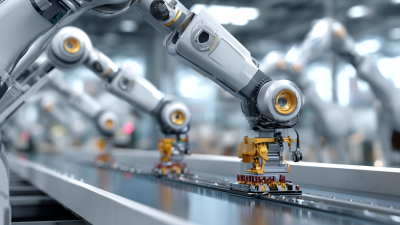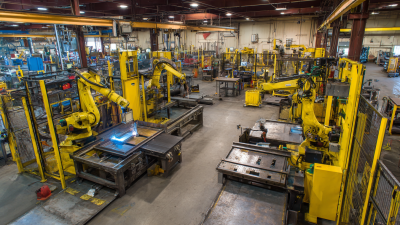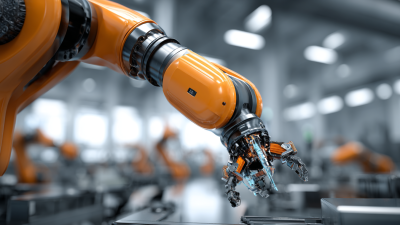Revolutionizing Efficiency: How Robotic Process Automation Solutions Transform Modern Workflows
In an era where efficiency drives competitive advantage, businesses are increasingly turning to robotic process automation solutions to streamline their workflows. According to a recent McKinsey report, organizations that adopt automation technologies can see productivity improvements of up to 30%, translating into significant cost savings and enhanced operational agility.

As digital transformation accelerates, the global RPA market is projected to reach $10 billion by 2027, reflecting a CAGR of over 30% (Gartner). This shift signifies not merely a technological change but a fundamental reimagining of how work is approached, enabling employees to focus on higher-value tasks while bots handle repetitive processes.
The integration of robotic process automation solutions is not just a trend; it's a paradigm shift that redefines business processes across industries, enhancing efficiency and paving the way for innovation.
The Rising Adoption Rates of Robotic Process Automation in Fortune 500 Companies
The adoption of Robotic Process Automation (RPA) has gained remarkable momentum among Fortune 500 companies, driven by the need for increased efficiency and reduced operational costs. According to a recent report by Gartner, 70% of large enterprises are expected to deploy RPA in their processes by 2024. This surge is indicative of a broader trend where organizations seek streamlined operations through automation, allowing human employees to focus on higher-value tasks.
Additionally, a study by McKinsey highlights that RPA can enhance productivity by up to 30%, illustrating its potential to revolutionize workflows across sectors. Fortune 500 firms are particularly keen on leveraging RPA not just for cost savings, but also for improving accuracy and compliance in their operations. As companies across various industries integrate these solutions, the long-term impact on workforce dynamics and job roles is set to be significant, making RPA a crucial component of modern business strategy.
Cost Reduction Benefits: How RPA Solutions Minimize Operational Expenses
Robotic Process Automation (RPA) is revolutionizing modern workflows by dramatically reducing operational costs across various industries. As organizations increasingly adopt RPA technology, they find significant savings by automating routine tasks such as data entry, invoice processing, and customer onboarding. This shift not only lowers expenses but also enhances productivity, allowing employees to focus on more strategic initiatives that drive business growth.

Tips for implementing RPA effectively include starting with a clear assessment of processes that can be automated, involving stakeholders from different departments to ensure a comprehensive understanding of workflows, and investing in training for employees to adapt to the new technology. By addressing potential resistance and fostering a culture of innovation, businesses can facilitate smoother integration of RPA solutions.
Moreover, RPA's impact is particularly notable in sectors like banking and finance, where it enhances compliance, risk management, and customer service. By streamlining operations, financial institutions can respond faster to market changes and customer needs, ultimately leading to greater operational efficiency and cost-effectiveness. Embracing RPA not only transforms operational landscapes but sets organizations on a path toward sustainable growth.
Enhancing Employee Productivity: RPA's Impact on Workforce Efficiency
In the age of digital transformation, Robotic Process Automation (RPA) is revolutionizing how businesses enhance workforce efficiency. Automation technologies streamline workflows, allowing employees to focus on more strategic tasks rather than mundane, repetitive ones. Recent studies indicate that up to 42% of financial activities can be fully automated with current technology, suggesting a significant shift towards a more efficient and productive workforce.
One of the key benefits of RPA is its ability to integrate seamlessly into existing systems, enhancing collaboration across departments. Organizations that implement RPA can experience not only reduced operational costs but also improved accuracy and speed in task execution. This shift is essential for companies aiming to remain competitive in an increasingly digital landscape.
Tip: To maximize the benefits of RPA, businesses should start by identifying repetitive tasks that can be automated and ensure that the RPA solutions chosen are scalable to meet future demands. Additionally, investing in training for employees will be crucial to leverage the full potential of these technologies effectively.
Impact of RPA on Workforce Efficiency
Industry-Specific Examples: RPA Transforming Banking, Healthcare, and Manufacturing
Robotic Process Automation (RPA) is making significant inroads into various industries, fundamentally transforming workflows. In the banking sector, for instance, a report from a leading financial services research firm indicated that RPA can reduce processing times by up to 80% for tasks such as account reconciliation and compliance reporting. This not only accelerates service delivery but also significantly lowers operational costs, allowing banks to redirect resources toward more strategic initiatives.
In healthcare, RPA is enhancing patient care management by automating administrative processes. According to a study by the Healthcare Information and Management Systems Society (HIMSS), healthcare organizations implementing RPA have reported a 30% reduction in patient onboarding times and a 50% decrease in administrative errors. This efficiency leap enables healthcare providers to focus more on patient interactions, ultimately improving outcomes and satisfaction.
Manufacturing is also witnessing a transformation driven by RPA. A report from McKinsey & Company found that the automation of repetitive tasks in manufacturing can yield productivity gains of 20-30%. As manufacturers harness RPA for supply chain management, inventory control, and quality assurance, they are becoming more agile and responsive to market demands, paving the way for smarter, more efficient production environments.

Future Trends: Predictive Analysis on RPA's Growth in the Next Decade
As organizations increasingly embrace robotic process automation (RPA), the potential for growth over the next decade is striking. According to a report by Gartner, RPA is expected to contribute to a reduction of operational costs by up to 30% by 2025. This improvement in efficiency is not just about cost-cutting; it is set to redefine how businesses operate, enabling them to allocate resources towards more strategic initiatives. The global RPA market, valued at around $1.57 billion in 2020, is anticipated to reach $11 billion by 2027, as highlighted in a report by Fortune Business Insights.
Future trends indicate a shift towards intelligent automation, where machine learning and artificial intelligence will bolster traditional RPA capabilities. A study by McKinsey asserts that nearly 70% of businesses are focusing on increasing their RPA adoption in the next five years. With this momentum, companies are expected to enhance their decision-making processes and productivity significantly. Predictive analytics will play a vital role, allowing businesses to foresee operational bottlenecks and respond proactively, thus ensuring sustained growth and competitive advantage in an ever-evolving marketplace.
Revolutionizing Efficiency: How Robotic Process Automation Solutions Transform Modern Workflows - Future Trends: Predictive Analysis on RPA's Growth in the Next Decade
| Year | RPA Market Size (USD Billion) | Annual Growth Rate (%) | Primary Industry Adoption (%) | Key Benefits (% of Companies) |
|---|---|---|---|---|
| 2023 | 2.5 | 25 | 35 | 80 |
| 2024 | 3.2 | 28 | 40 | 85 |
| 2025 | 4.5 | 30 | 50 | 90 |
| 2026 | 6.0 | 32 | 55 | 92 |
| 2027 | 8.0 | 34 | 60 | 95 |



